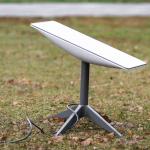
Connecting to Starlink: A Step-by-Step Guide
By Complete Electrical Service|March 09, 2023
When Elon Musk launched SpaceX in 2003, his primary goal was to reignite space exploration by lowering transportation costs.
After making a name for cost-effectively launching spacecraft and rockets in low earth orbit and further, Elon Musk decided to leverage Low Earth Orbit (LEO) satellites to provide internet services. This new venture, Starlink, has proven to be an exceptional innovation.
What is Starlink, and how does it work? Let's answer these questions in detail as we look at the pros and cons and a step-by-step guide for connecting to Starlink.
What is Starlink and How Does It Work?
Starlink is a satellite-based internet service that offers high-speed broadband and low-latency connections. It operates through a network of satellites positioned at different heights across multiple orbits, which transmit signals to user terminals on the ground.
The connection completes when these user terminals receive satellite data via radio waves, which they then decrypt into usable internet service.
Where is Starlink Available?
In Australia, Starlink is currently available in most states, with more regions coming on board as the service expands.
SpaceX started with a few ground stations in southern New South Wales and northern Victoria but has now expanded to 20 ground stations across Western and Southern Australia and Queensland.
How to Connect to Starlink
Considering Starlink? Talk to an experienced electrical installer today. Starlink is a revolutionary technology that offers unparalleled reachability and reliability, even in remote locations. It provides an affordable alternative in rural areas where broadband services are typically scarce or nonexistent. These benefits make Starlink a great choice if you’re looking for reliable internet connections, no matter your location.
After making a name for cost-effectively launching spacecraft and rockets in low earth orbit and further, Elon Musk decided to leverage Low Earth Orbit (LEO) satellites to provide internet services. This new venture, Starlink, has proven to be an exceptional innovation.
What is Starlink, and how does it work? Let's answer these questions in detail as we look at the pros and cons and a step-by-step guide for connecting to Starlink.
What is Starlink and How Does It Work?
Starlink is a satellite-based internet service that offers high-speed broadband and low-latency connections. It operates through a network of satellites positioned at different heights across multiple orbits, which transmit signals to user terminals on the ground.
The connection completes when these user terminals receive satellite data via radio waves, which they then decrypt into usable internet service.
Where is Starlink Available?
In Australia, Starlink is currently available in most states, with more regions coming on board as the service expands.
SpaceX started with a few ground stations in southern New South Wales and northern Victoria but has now expanded to 20 ground stations across Western and Southern Australia and Queensland.
How to Connect to Starlink
- Verifying the Installation Location
The first step is ensuring you have an optimal location for the Starlink user terminal. This means checking for obstructions, such as trees or buildings, that could interfere with a clear line of sight between the device and the satellites.
- Assembling the Device
Once you have a suitable location, you can begin assembling the Starlink user terminal by following the instructions provided by Space X. It comprises several parts, so ensure you secure and fasten all components according to specified directions.
- Installation
After assembly, find a spot for the router at least four feet away from objects that may interfere with signal reception.
- Connecting to the Starlink Network
You can then connect your User Terminal directly to the modem/router connection port.
Power up the unit, then use your computer or mobile application (e OS) provided by SpaceX to establish a secure link between your device and the satellite system.
- Low Latency and High Bandwidth
The low latency and high bandwidth of Starlink ensure a reliable internet connection. The satellite network has average latencies of around 20ms, making it perfect for video streaming, gaming, sending large files, and more.
- Fast Data Transmission Speeds
Starlink offers fast data transmission speeds of up to 1 Gbps with low latencies. Every satellite can transfer large amounts of data, often more than 50 Mbps at once, so download speeds are consistent even during peak hours.
- Easy-to-setup User Terminal
Installing a Starlink User Terminal is straightforward. Once you set up the devices, you need to connect your User Terminal directly to the modem/router connection port via Ethernet cable or wirelessly.
- Reachability in Remote Areas
Starlink's network of satellites provides impressive reachability and reliability, even in the most isolated locations.
- Cost
The cost of hardware can be a potential downside to using Starlink. The estimated price for the user terminal alone is around $924, while shipping fees and monthly charges add to the total cost.
- Reliability Issues
Another potential downside is reliability due to latency or outages. Although Space X designed the network of satellites at different heights and in multiple orbits, there could be occasional connection interruptions due to weather conditions affecting signal reception.
Considering Starlink? Talk to an experienced electrical installer today. Starlink is a revolutionary technology that offers unparalleled reachability and reliability, even in remote locations. It provides an affordable alternative in rural areas where broadband services are typically scarce or nonexistent. These benefits make Starlink a great choice if you’re looking for reliable internet connections, no matter your location.



